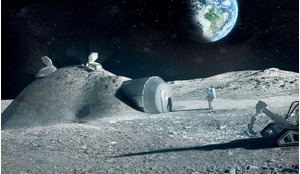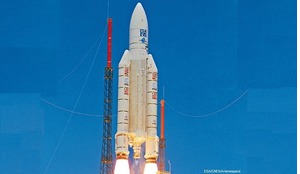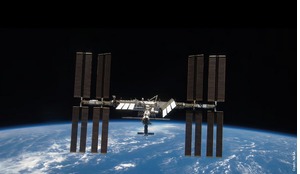Agent for change Katherine Courtney campaigns to keep the unique space environment safe and sustainable, advocating for space traffic control solutions to tackle the risks from rapidly growing volumes of spacecraft and orbital debris. This self-confessed ‘child of the Apollo generation’ and Chair of the Steering Board for the Global Network on Sustainability in Space (GNOSIS), spoke to ROOM Editor-in-Chief Clive Simpson about her passionate vision for improving the way we do things in space.
 Katherine Courtney.
Katherine Courtney.
How important is sustainability when it comes to space and the low Earth orbit (LEO) environment?
It’s critical, absolutely critical. The forecasts for the size of the global space market vary between one trillion and three trillion dollars and assume all sorts of leading-edge developments, such as in-orbit servicing and manufacturing, habitats and the development of an in-orbit economy, even extending to other planetary bodies and extracting resources from asteroids.
None of that can happen if we clutter up the near-Earth space environment with so many satellites and so much debris that nothing can even get through. As things stand we are on a trajectory to do that. So we need to understand very quickly how to avoid leaving more junk in the middle of the road and also how to drive international agreements to make access to space more sustainable. Binding rules will be critical for the future growth of the space community, otherwise it is all going to grind to a halt.
 American astrophysicist and retired NASA scientist, Donald J Kessler, pioneered the study of space debris. He realised that, left unchecked, orbiting debris could cause a chain reaction of satellite collisions, which has been dubbed ‘The Kessler Syndrome’.
American astrophysicist and retired NASA scientist, Donald J Kessler, pioneered the study of space debris. He realised that, left unchecked, orbiting debris could cause a chain reaction of satellite collisions, which has been dubbed ‘The Kessler Syndrome’.
Literally any day there could be an Exxon Valdez-type disaster in orbit that triggers the Kessler Syndrome [a theory proposed by NASA scientist Donald J Kessler in 1978 to describe a self-sustaining cascading collision of space debris in LEO]. Indeed, some scientists say that we’re already living in a Kessler Syndrome scenario, which is playing out over a very long time frame, so it’s not ‘visible’ to us.
I believe that you can’t have enthusiasm about all of the benefits of space unless you start thinking about how we safeguard that unique operating environment in a more sustainable way than we’ve done for the last 50 years. People are starting to talk more about space sustainability, but we need to avoid ‘space greenwashing’. In my opinion, it’s time for for less talk and more science, more solutions.
Given what is happening today, do you think sustainability in space is realistic? After all, the reality is you have a whole bunch of new satellites being launched every week by the likes of SpaceX and others.
Some scientists say that we’re already living in a Kessler Syndrome scenario, which is playing out over a very long time frame
My personal view is that you can’t regulate for things you can’t enforce, so the key that will actually accelerate progress on all of this is much better data about what is going on in space and much more sophisticated modelling of the orbital debris population.
Today it’s basically a free-for-all. We’re trying to regulate a 21st century space industry with tools and techniques that were developed in the 1960s based on international agreements from the 1980s.
These agreements are also non-binding and, in my opinion, obsolete. The solutions for space traffic management are also obsolete, because they were designed for a time when there were a couple of thousands objects up there and they all belonged to government entities.
A year in the making, my photography for Our Fragile Space took me to the top of volcanoes in the Pacific and Atlantic Oceans, clean rooms across Europe, mega-constellation launches on both coasts of the United States within a few days of each other, and a farm in England. It also took me on a journey through the space sector, government, space agencies, military, regulation, insurance market, academia, astronomy, and space sustainability.
Our Fragile Space takes a human perspective, from the ground looking up, connecting the Earth to the near-space environment. I chose this everyday approach to make the issues more tangible because space debris is just up there, part of Earth’s environment.
Human activity over hundreds of years has led to global changes on the land, in the oceans, with plastic in particular, in the atmosphere, leading to climate change – and now in space with space debris. We are only 65 years into the Space Age so we have an opportunity to not repeat the same behaviour; the sustainability imperative is becoming embedded within us.
Space-driven innovation has always shown the way including down here on Earth. The space sector, stretching all the way to regulation, is full of inspiring, talented, creative and motivated people. They have led us to a better way of life on Earth - and I believe will lead us to a better, more sustainable path in space. Protecting the near-space environment is in everyone’s interests - so let’s go!
Max Alexander

Eighty percent of objects in orbit now belong to commercial companies, not to governments, and yet the responsibility for monitoring that traffic, or managing it or issuing licenses, rests with national governments and some high-level principals through international treaties. These treaties are largely unenforceable. For example, the liability convention which lots of countries have signed up to has never been tested in a court of law, because you would never be able to have an undisputed set of evidence that said who caused what accident.
Is the UK sustainability report
‘world leading’ or are there other initiatives about?
The UK has definitely brought the subject to the international agenda. Being the nation that introduced the UN resolution on norms and behaviours of responsible use of space was very important and it paved the way for the US to make its declaration that it will halt the testing of anti-satellite missiles.
The UK is not the only country, however, because one of the guiding principles in the US space directives, even during the Trump administration, was the sustainable use of space.
But the UK is really the first country to make sustainability a key priority in both its commercial and defence space strategies, building capability so that we can see better what’s actually going on up there. If you have more transparency and better monitoring, accidents are less likely to happen. If they do, they’re less likely to be misinterpreted and escalate tensions. And irresponsible actors can be watched..
We’re trying to regulate a 21st century space industry with tools and techniques that were developed in the 1960s based on international agreements from the 1980s
I’m heartened by the number of private sector start-ups that are interested in space traffic management and developing solutions, because we’re still living in a quite hostile world. Over the last few years, everybody seems to have been declaring space a war-fighting domain, forming space commands and putting more military budgets into that. But because there are so many private sector players fielding the sensors and capabilities to reveal what people are doing, there might be a bit more accountability and a little less secrecy.
And Global Network on Sustainability in Space (GNOSIS), the organisation you’re with now, how does that fit in?
The Global Network on Sustainability in Space is funded by the UK’s Science & Technology Facilities Council (STFC) that aims to bring researchers together with industry to try and tackle these problems. Initially, the funding we have is only deployable in the UK so that’s been a bit of a stumbling block.
We launched at the end of 2019 and held our first hybrid conference at the end of that year. In that time, we have grown from nothing to about 360 members which are about evenly split between industry and academia. They span across 20 countries and 60 research organisations.
 Removing old spacecraft from orbit is essential for the sustainable use of space. Professor Yang Gao, Surrey Space Centre, examines an experimental robotic arm that is designed to grab pieces of space debris and pull them out of orbit.
Removing old spacecraft from orbit is essential for the sustainable use of space. Professor Yang Gao, Surrey Space Centre, examines an experimental robotic arm that is designed to grab pieces of space debris and pull them out of orbit.
What is the fundamental message and have we really got to take notice of all this now?
I’m heartened by the number of private sector start-ups that are interested in space traffic management
We have to! The pace at which space is being populated is unsustainable, so unless we actually start to find the solutions to that now it will be too late.
The global economy has become so reliant on space services. Does anybody leave home today without a SatNav in their pocket and where would we have been in the pandemic without groceries delivered to the door. Did you know that if you walk 500 metres, your phone can be connected to as many as 27 different satellites? In my experience, there are so many people who just don’t understand that ‘SatNav’ is satellite navigation; they don’t get that the “Sat” means it’s coming from space!
We rely on so many satellite services every day and all of the services we rely on are dependent on maintaining the space environment.
From an ethical point of view, it is the big spacefaring nations that are taking up all the space in space. Space cannot be locked up just by 11 launching states. The other 135 signatories to the Outer Space Treaty should also have an opportunity to benefit from that environment. It needs to be preserved so that access can be more democratised, but it also needs to be preserved for all our children and grandchildren.
I am of the generation that has caused the mess, the Apollo generation, and we can say we didn’t know any better at the beginning. But when you go and talk to kids about who put the plastics in the ocean, they say we did. Space junk came from us too, the grown-ups. We really do need to make sure that future generations have the same potential as we did.
So how do you explain it to people that perhaps don’t understand - is what we’ve done to Earth’s climate a good parallel? And are there links between climate change and space debris?
It’s an excellent parallel and there are definite connects because more than half of UN climate variables monitored today - that measure how badly we are messing up Earth’s environment – come from satellite observations and data.
The shrinking of the polar ice caps, for example, can only realistically be monitored from Earth orbit: it is a unique vantage point from which to monitor our own environment. We will lose that if we make it impossible for satellites to operate safely - there is a linkage between preserving the space environment and preserving Earth’s environment.
The fact that we can’t ‘see’ all that orbital debris and all the inoperable satellites doesn’t mean that it’s not there and is not something to worry about. There’s now a very clear narrative that says “Let’s not make the same mistake in our near-Earth environment that we have made with Earth’s terrestrial environment”.
There is a linkage between preserving the space environment and preserving Earth’s environment
We still have some time to get the science right and put international agreements in place. I almost hate to say it but it does need international regulation. And you will even hear some satellite operators volunteering that they believe it needs regulation, which is unusual for commercial companies, but they know that if there’s a big ‘car crash’ up there, their revenue stream goes with it.
I’m very happy to see that the issue has climbed the political and policy agenda. Now, the question is what’s the delivery route map for that. I think that’s an area where the government could really use more help from industry and academia, to help set up the practical steps. We certainly need to solve all the technical problems of understanding what would make space more sustainable, but the big trick is setting up regulatory frameworks on a global basis.
 Senior systems engineers Zoé Tenacci (and Rosie Linehan act out the delicate process of capturing one satellite with another. Astroscale Ltd are currently investigating numerous ways to deal with space debris. These include the active removal of debris in orbit using special missions, servicing satellites to refuel them and extend their lives, and space situational awareness systems that will make predicting and therefore avoiding collisions easier.
Senior systems engineers Zoé Tenacci (and Rosie Linehan act out the delicate process of capturing one satellite with another. Astroscale Ltd are currently investigating numerous ways to deal with space debris. These include the active removal of debris in orbit using special missions, servicing satellites to refuel them and extend their lives, and space situational awareness systems that will make predicting and therefore avoiding collisions easier.
Is this a big challenge, especially when you look at how the world is grappling with the climate crisis?
It certainly is huge but there’s no reason why the UK can’t lead it. We can be founding members of whatever organisation it takes to sort the mess in low Earth orbit. One of the key things we can do is get more of the general public interested and aware.
If we ignore it and make a mess up there it will turn the clocks back to the 1950s: you will get your news on pieces of paper, you will not be able to order your groceries online and your mobile phone won’t work everywhere. We won’t be able to do any of these things if we don’t solve this problem.
And that’s part of my mission and what I am focused on: the issue of sustainability in low Earth orbit. I want to get that out a lot more to the general public, not just the space people because we should already understand it.














